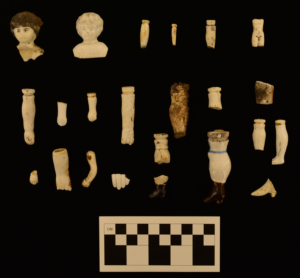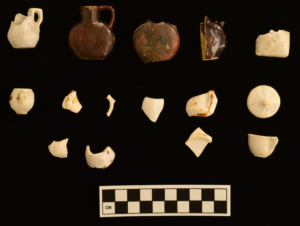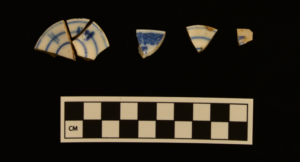
Figure 1. Site 40KN223 is located at the confluence of Downtown (Blue), East Knoxville (Green), and North Knoxville (Purple). The area outlined in orange represents the University of Tennessee, Knoxville.
Sometime in the last quarter of the nineteenth century, children would have been playing in a small residential neighborhood in the Old City of Knoxville, Tennessee. We know this happened because the toys of those children were excavated from an archaeological site labeled “40KN223” during the winter of 2019. The site is located behind Barley’s Taproom and is currently occupied by the new Stockyard Lofts building.

Figure 2. Redware, White Clay, Porcelain, and Stoneware marbles from site 40KN223.
The featured artifacts of the month of February are the ceramic toys excavated from this site. Marbles, dolls, doll accessories, figurines, and child-size dinner wares represent the kinds of toys excavated. Artifacts, like the marbles seen in Figure 2, demonstrate to the researcher that children were actively playing on and around this site. While these artifacts are an indication that children were present and playing on this landscape, they have the potential to tell us so much more.

Figure 3. Doll parts excavated from 40KN223. Most are plain, but some are decorated with both underglaze and overglaze decorations.
Each type of toy serves a specific purpose during playtime activities. Marbles, for example, are a classic type of game piece, useful for many different games and variations of games. Dolls, as another example, were useful for a different type of playtime activity. While these toys were marketed for girls, both girls and boys could use dolls to emulate having a child of their own, or perhaps as a vessel through which they could live out their childhood fantasies.

Figure 4. These artifacts include vessel forms like pitchers (upper left), teacups (middle), and teapots (lower right).
Much like the toy dolls of today, these dolls were sold with accessory items like hammocks, bedroom sets, furniture sets, stoves and ranges, toilet wares, clothing items, and dining sets. At 40KN223, kitchen dining ware accessories were found. Miniature plates, saucers, teacups, teapots, and pitchers visible in Figures 4 and 5 represent the different kinds of dinner ware accessories the children of this neighborhood would have been playing with alongside their dolls.

Figure 5 displays flatware vessels with blue hand-painted decorations meant to imitate common styles of the time.
Archaeologically, children can be difficult to identify due to the minimal impact they have on the archaeological record. Generally, urban archaeological features or deposits of artifacts can, at best, be associated with a particular household or structure based on the distance they have from a structure or property boundary. There are instances where an archaeologist can attribute an artifact to a particular person or type of person (such as engraved initials on a toothbrush or a perfume bottle that would have likely been marketed towards females), but these types of artifacts are uncommon. However, even if a deposit of artifacts can be attributed to a household or property, children can still be difficult to spot. How are archeologists supposed to tell if a generic glass bottle or ceramic mug was used or deposited by an adult or a child? Toys, on the other hand, offer strong evidence of children in the archaeological record and are one of the few types of artifacts that can be reliably attributed to children’s activity on the landscape.